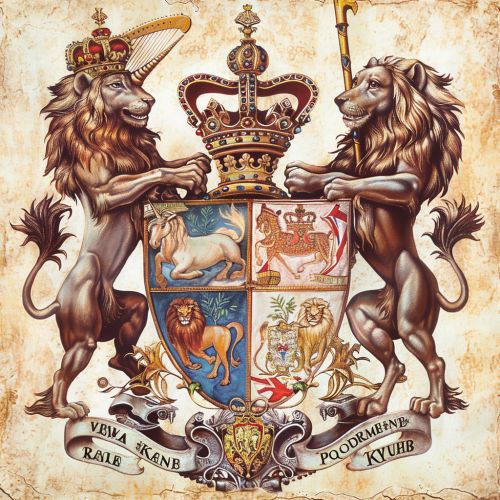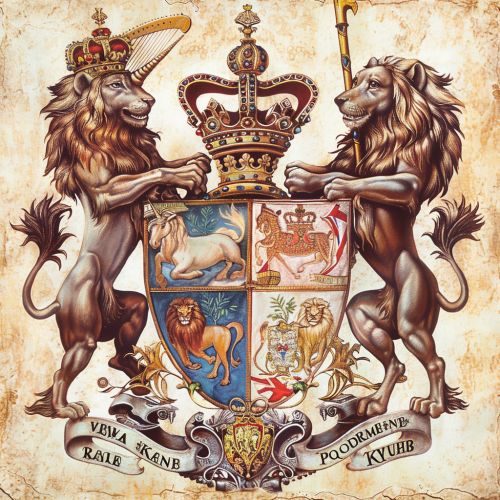Coat of Arms of the United Kingdom: Difference between revisions
(Created page with "== Introduction == The Coat of Arms of the United Kingdom is a heraldic emblem that represents the monarchy and the country. It is used by the British monarch and government as a symbol of authority and national identity. The coat of arms has evolved over centuries, incorporating elements from the various realms that have united to form the United Kingdom. This article delves into the intricate details, history, and symbolism of the Coat of Arms of the United Kingdom. =...") |
No edit summary |
||
| Line 32: | Line 32: | ||
The compartment beneath the shield is adorned with a thistle, rose, and shamrock, representing Scotland, England, and Ireland, respectively. | The compartment beneath the shield is adorned with a thistle, rose, and shamrock, representing Scotland, England, and Ireland, respectively. | ||
[[Image:Detail-97373.jpg|thumb|center|Coat of Arms of the United Kingdom featuring a quartered shield with lions, a harp, and a unicorn, supported by a lion and a unicorn, with a crowned lion crest and mottoes.|class=only_on_mobile]] | |||
[[Image:Detail-97374.jpg|thumb|center|Coat of Arms of the United Kingdom featuring a quartered shield with lions, a harp, and a unicorn, supported by a lion and a unicorn, with a crowned lion crest and mottoes.|class=only_on_desktop]] | |||
== Evolution of the Coat of Arms == | == Evolution of the Coat of Arms == | ||
Latest revision as of 03:20, 28 July 2024
Introduction
The Coat of Arms of the United Kingdom is a heraldic emblem that represents the monarchy and the country. It is used by the British monarch and government as a symbol of authority and national identity. The coat of arms has evolved over centuries, incorporating elements from the various realms that have united to form the United Kingdom. This article delves into the intricate details, history, and symbolism of the Coat of Arms of the United Kingdom.
Historical Background
The origins of the Coat of Arms of the United Kingdom can be traced back to the early medieval period. The earliest known arms were those of the Kingdom of England, which featured three golden lions on a red field, known as the "Royal Arms of England." These arms were first used by King Richard I in the late 12th century.
With the union of the crowns of England and Scotland in 1603 under King James VI of Scotland (James I of England), the royal arms were redesigned to incorporate the symbols of both kingdoms. The Act of Union in 1707 further unified England and Scotland into the Kingdom of Great Britain, necessitating another redesign. The final major change came with the Act of Union in 1801, which united Great Britain and Ireland, resulting in the current design.
Design and Symbolism
The Coat of Arms of the United Kingdom is rich in symbolism, reflecting the history and unity of the country. The current design consists of several key elements:
Shield
The shield is quartered, representing the four constituent parts of the United Kingdom:
- The first and fourth quarters feature the three lions passant guardant of England.
- The second quarter displays the lion rampant of Scotland.
- The third quarter shows the harp of Ireland.
Supporters
The shield is supported by two animals:
- The dexter supporter is a crowned English lion.
- The sinister supporter is a Scottish unicorn.
Crest
Above the shield is the royal crest, which consists of a crowned lion standing on a royal crown.
Mottoes
The coat of arms features two mottoes:
- "Dieu et mon droit" (God and my right) is the motto of the British monarch.
- "Honi soit qui mal y pense" (Shame on him who thinks evil of it) is the motto of the Order of the Garter, displayed on a blue garter surrounding the shield.
Compartment
The compartment beneath the shield is adorned with a thistle, rose, and shamrock, representing Scotland, England, and Ireland, respectively.


Evolution of the Coat of Arms
The Coat of Arms of the United Kingdom has undergone several changes throughout history, reflecting the political and dynastic shifts in the country.
Early Arms of England
The earliest form of the royal arms was the three lions of England, adopted by Richard I. This emblem became a symbol of the English monarchy and was used by subsequent kings.
Union of the Crowns
In 1603, James VI of Scotland inherited the English throne, becoming James I of England. He combined the arms of England and Scotland, quartering the three lions of England with the lion rampant of Scotland.
Act of Union 1707
The Act of Union in 1707 united England and Scotland into the Kingdom of Great Britain. The royal arms were redesigned to reflect this union, incorporating the symbols of both kingdoms.
Act of Union 1801
The Act of Union in 1801 united Great Britain and Ireland, resulting in the current design of the coat of arms. The harp of Ireland was added to the third quarter of the shield, and the overall design was refined to its present form.
Usage and Legal Status
The Coat of Arms of the United Kingdom is used by the monarch and various government institutions. It appears on official documents, currency, and public buildings. The use of the coat of arms is regulated by law, and unauthorized use is prohibited.
Royal Warrant
The use of the coat of arms is granted by royal warrant, a formal document issued by the monarch. This warrant specifies who is authorized to use the coat of arms and under what circumstances.
Government Usage
The coat of arms is used by various government departments and agencies, including the Prime Minister's Office, the Foreign and Commonwealth Office, and the Home Office. It is also used on official documents such as passports and driving licenses.
Symbolism and Interpretation
The elements of the Coat of Arms of the United Kingdom are rich in symbolism, representing the history and unity of the country.
Lions of England
The three lions passant guardant of England symbolize strength, courage, and nobility. They have been a symbol of the English monarchy since the reign of Richard I.
Lion of Scotland
The lion rampant of Scotland represents bravery and valor. It has been a symbol of the Scottish monarchy since the 12th century.
Harp of Ireland
The harp of Ireland symbolizes the cultural and artistic heritage of Ireland. It has been a symbol of the Irish monarchy since the Middle Ages.
Unicorn of Scotland
The unicorn is a mythical creature symbolizing purity and strength. It has been a symbol of Scotland since the 15th century.
Crowned Lion Crest
The crowned lion standing on a royal crown represents the sovereignty and authority of the British monarch.
Mottoes
The motto "Dieu et mon droit" reflects the divine right of kings, while "Honi soit qui mal y pense" signifies the chivalric values of the Order of the Garter.
Variations and Regional Arms
In addition to the main Coat of Arms of the United Kingdom, there are several regional variations used by different parts of the country.
Royal Arms of Scotland
The Royal Arms of Scotland feature a red lion rampant on a yellow field, surrounded by a double tressure flory-counter-flory. This design is used by the monarch in Scotland and appears on various official documents and buildings.
Royal Arms of Ireland
The Royal Arms of Ireland feature a gold harp on a blue field. This design is used by the monarch in Northern Ireland and appears on various official documents and buildings.
Royal Arms of Wales
While Wales does not have a separate coat of arms, the Welsh dragon is often used as a symbol of the country. The dragon appears on the Welsh flag and various official documents and buildings.
Heraldic Authority
The College of Arms is the official heraldic authority in England, Wales, and Northern Ireland. It is responsible for granting and regulating coats of arms, including the Coat of Arms of the United Kingdom.
College of Arms
The College of Arms was established in 1484 by King Richard III. It is headquartered in London and is responsible for maintaining records of coats of arms and pedigrees. The college is headed by the Garter Principal King of Arms, who is the senior heraldic officer in England.
Lord Lyon King of Arms
In Scotland, the Lord Lyon King of Arms is the official heraldic authority. The office was established in the 14th century and is responsible for granting and regulating coats of arms in Scotland. The Lord Lyon is based in Edinburgh and is the senior heraldic officer in Scotland.
Modern Usage and Representation
The Coat of Arms of the United Kingdom continues to be an important symbol of the monarchy and the country. It is used in various contexts, from official documents to public buildings, and remains a powerful emblem of national identity.
Official Documents
The coat of arms appears on a wide range of official documents, including passports, driving licenses, and government publications. It is also used on official seals and stamps.
Public Buildings
The coat of arms is displayed on many public buildings, including government offices, courthouses, and embassies. It is often carved in stone or cast in metal and serves as a symbol of the authority and legitimacy of the government.
Currency
The coat of arms appears on various forms of currency, including coins and banknotes. It is used as a symbol of the nation's economic stability and sovereignty.
Ceremonial Usage
The coat of arms is used in various ceremonial contexts, including state occasions, royal weddings, and official visits. It is often displayed on banners, flags, and other ceremonial items.
See Also
- Heraldry
- Royal Arms of England
- Royal Arms of Scotland
- Royal Arms of Ireland
- College of Arms
- Lord Lyon King of Arms
